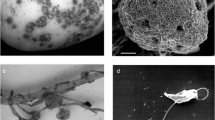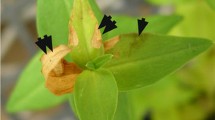Abstract
One or two cycles of late blight transmission may occur in cut potato seed between cutting and emergence. If seed are not planted immediately, mycelium from diseased pieces can infect across adjoining cut surfaces within 8 hr. Sporangia production begins on freshly cut diseased tubers in 1–2 days, on mycelium-infected seed pieces within 4–5 days, and on spore-infected seed pieces in about 1 wk. These spores are further dispersed during handling and planting, and may infect contaminated seed in the ground, regardless of suberization. Sporangia can be transferred to healthy tubers on cutting knives, although this appears infrequent. The risk and degree of secondary spread increase with the length of time cut seed are held before planting. Such secondarily infected seed are more likely to survive and produce infected stems than the original infected tubers. Treatment of seed with appropriate fungicides immediately after cutting substantially reduces or prevents transmission of late blight to healthy seed. Certain seed treatments withoutPhytophthora-specific components may increase the risk of tuber blight.
Similar content being viewed by others
Literature Cited
Beukema, H.P. and D.E. van der Zaag. 1990. Introduction to potato production. PUDOC, Wageningen 208 pp.
Bonde, R. and E.S. Schultz. 1943. Potato refuse piles as a factor in the dissemination of late blight. Me Agric Expt Sta Bull.416. pp. 229–246.
Caten, C.E. and J.L. Jinks. 1968. Spontaneous variability of single isolates ofPhytophthora infestons. I. Cultural variation. Can J Bot 46:329–348.
DeBary, A. 1861. Die gegenwärtig herrschende Kartoffelkrankheit, ihre Uhrsache und ihre Verhütung. 75 p. Leipzig.
Deahl, K.L. 1995. Potato tuber’s role in the late blight complex. Proc Natl Potato Council Seed Sem 14:10–16.
Dowley, L.J. and E. O’Sullivan. 1991. Sporulationof Phytophthora infestons (Mont.) De Bary on the surface of diseased potatoes and tuber to tuber spread of infection during handling. Potato Res 34:295–296.
Fairclough, R.W., R.A. Bain, and S.J. Holmes. 1997. The infection of potatoes byPhytophthora infestans during simulated washing and its control using a hot water treatment. Potato Res 40:91–99.
Goodwin, S.B., B.A. Cohen, K.L. Deahl, and W.E. Fry. 1994. Migration from Northern Mexico as the probable cause of recent genetic changes in populations ofPhytophthora infestans in the United States and Canada. Phytopathology 84:553–558.
Kadish, D. and Y. Cohen. 1992. Overseasoning of metalaxyl-sensitive and metalaxyl-resistant isolates ofPhytophthora infestans in potato tubers. Phytopathology 82:887–889.
Lambert, D.H. and A.I. Currier. 1997. Differences in tuber rot development for North American clonesof Phytophthora infestans. Am Potato J 1997. 74:39–43
Löhnis, M.P. 1922. Onderzoek overPhytophthora infestans (Mont.) de By. op de aardappelplant. Ph.D. Dissertation, Univ. Utrecht.
Ludy, R.L. and M.L. Powelson. 1997. Seed piece treatment for control of late blight of potato. Am. Potato J 74:445–446 (Abstract).
Melhus, I.E. 1915. Hibernationof Phytophthora infestans of the Irish potato. J Agric Res 5:71–112.
Murphy, P.A. and R. M’Kay. 1927. Some further cases of the production of diseased shoots by potato tubers attacked byPhytophthora infestans, and a demonstration of alternative sources of foliage and tuber infection. Sci Proc Roy Dublin Soc. 18:413–423.
Secor, G.A. and N.C. Gudmestad. 1993. Handling and planting seed tubers. Pp 27–34In Potato health management, R.C. Rowe ed., Am Phytopath Soc, St. Paul.
Shattock, R.C. 1976. Winter survival of field isolates ofPhytophthora infestans in seed tubers and development of primarily infected plants. Ann Appl Biol 84:273–274.
Steel, R.G.D. and J.H. Torrie. 1960. Principles and procedures of statistics. McGraw Hill, New York. 481 p.
Walker, A.S.L. and L.R. Cooke. 1990. The survival ofPhytophthora infestans in potato tubers — the influence of phenylamide resistance. Brighton Crop Prot Conf Pests Diseases 3:1109–1114.
Zaag, D.E. van der. 1956. Overwintering en epidemiologie vanPhytophthora infestans, tevins enige nieuwe bestrijdingsmogeliekheden. Tijd. Pl.ziekten 62:89–156.
Author information
Authors and Affiliations
Corresponding author
Additional information
Maine Agricultural and Forestry Research Station external publication 2239.
Rights and permissions
About this article
Cite this article
Lambert, D.H., Currier, A.I. & Olanya, M.O. Transmission ofPhytophthora infestans in cut potato seed. Am. J. Pot Res 75, 257–263 (1998). https://doi.org/10.1007/BF02853604
Accepted:
Issue Date:
DOI: https://doi.org/10.1007/BF02853604




